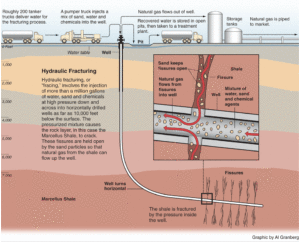In areas where oil and gas development is prevalent, air, water and soil resources can become contaminated with oil and gas wastes and byproducts. Read about the primary pathways for contamination.
Citizens commonly report that drilling and production activities contaminate water wells, surface waters and soils surrounding well sites; and that air emissions from drilling sites, well heads, compressor stations, pipelines and other oil and gas field infrastructure contribute to air quality concerns.
Water Pollution
- Hydraulic fracturing is a practice that may involve the injection of known toxic chemicals into or close to drinking water supplies.
- Stormwater runoff during construction or runoff from established well pads can introduce sediment and toxic chemicals into nearby rivers and streams
- Storage and disposal of drilling and production wastes in pits can contaminate groundwater and surface waters
- A variety of air contaminants are emitted throughout the oil and gas development process.
- Air pollution also impacts the health of communities surrounded by oil and gas development, read our study Gas Patch Roulette.
- Flaring, the burning of excess natural gas at oil and gas wells, causes methane pollution, a potent greenhouse and contributor to climate change.
Soil Pollution
- Oil and gas industry wastes, which may contain petroleum hydrocarbons, metals, naturally occurring radioactive materials, salts and toxic chemicals, have the potential to cause soil pollution, and prevent the growth of vegetation.
- Produced water, which may contain high concentrations of salts and other contamiants, is often stored in pits or disposed of in evaporation ponds. Spills of produced water can kill vegetation and sterilize soils.
- Contaminants that enter the soil do not necessarily stay put. They can move down through the soil and contaminate groundwater, or up through the soil and be released to air. Learn about the subsurface transport of oilfield wastes.
For More Information
- Chapter 1 of Oil and Gas at Your Door? A landowner’s guide to oil and gas development contains general information on contaminants associated with oil and gas development.
OGAP Fact Sheets
- Oil and Gas Pollution Fact Sheet: Contaminants associated with the various stages of oil and gas development
- Pits Fact Sheet: Contamination and regulation issues





